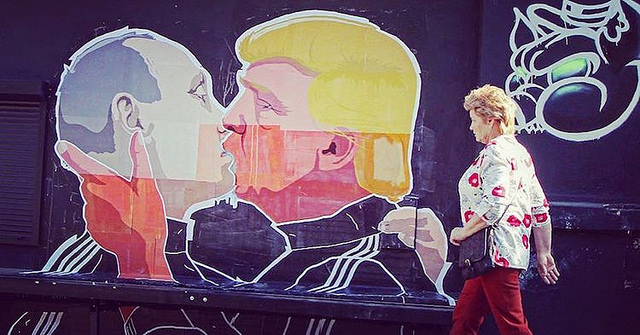The world is awash in conspiracy theories, fake news and “alternative facts.” Nowhere is this more true than in Russia under Vladimir Putin, who sees the “hidden hand” of the West moving against the Russian nation. This month, Origins presents something a little different. We offer an exhibition of political cartoons and caricatures, curated by historian Stephen Norris, by the cartoonist Boris Efimov whose extraordinary career from 1922 to 1991 illustrates the ways in which the Soviet Union saw the conspiracy of the West always at work—and how those ideas of the invisible, nefarious influences of America continue today.
Conspiracy theories have proliferated in both the United States and Russia since the collapse of the Soviet Union.
In Russia, they even form part of the Kremlin’s public diplomacy. Russian media depicted the election protests in Moscow and St. Petersburg (and throughout the country) in December 2011 as the product of a Western plan to undermine Russia. The 2012 Pussy Riot scandal revealed a “conspiring subversive minority.” And the press described the 2014 Euromaidan Revolution in Ukraine as a CIA plot.
Russian President Vladimir Putin dismisses stories that his government has engaged in conspiratorial activities to alter elections. Yet he does so while he has also criticized the United States for conspiratorial activities in the former Soviet world. This view that Russia has faced conspiracies designed to weaken the Russian nation since 1991 has moved from the margins to the mainstream in Russia over the past two decades.
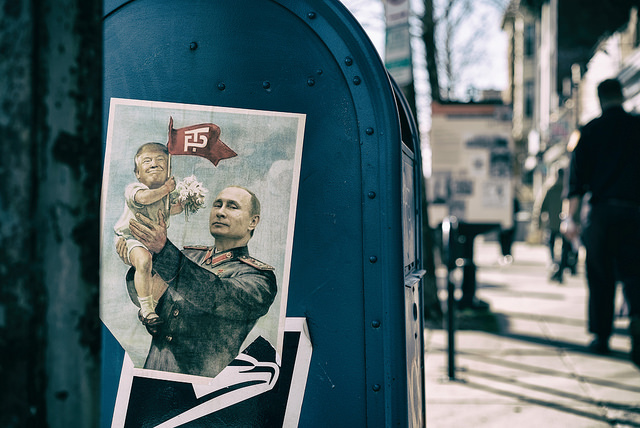
This worldview, not surprisingly, has deep historical roots. The conspiracy theories of Putin’s tenure build on ideas developed in the Soviet period. Russian history is replete with stories of enemies seeking to undermine the state: conspiracy theories, as many scholars have argued, tend to surface when a given society has an “other” against whom “the people” can rally support.
In Russia, “the West,” broadly imagined, has historically played this role, particularly across the 20th century. From the beginning of their radical experiment, Bolshevik leaders constantly warned that the West threatened to undermine the attempt to build socialism. Soviet officials and propagandists stressed that the hidden hands of the West stretched to all corners of the earth, working behind the scenes to prevent Soviet achievements.
As we will see—and seeing is crucial to this understanding—Soviet political cartoons consistently visualized this worldview from 1917 to 1991. Caricatures conjured up a reality, brought it into focus, and repeated it in order to encourage a specific way of seeing the world.
While we should not ascribe this worldview to all Soviet citizens, we should pay attention to the consistent message this form of Soviet media offered to its citizens. As innumerable publications attested, Soviet caricatures were meant to be “weapons” in the struggle to build socialism and to construct a new, Soviet person.
The Not-So-Hidden Hands of the “West”: Boris Efimov
The most prolific propagandist in this visual warfare was Boris Efimov, who was named principal political caricaturist for the newspaper Izvestiia [News] in 1922, the year the USSR was officially founded, and who worked for that publication until 1991, the year the USSR collapsed. Efimov, a self-trained artist who first started drawing cartoons for the Bolsheviks in 1918, also helped to found the influential and popular satirical magazine Krokodil [Crocodile] in 1922 and the equally influential magazine Ogonek [Little Spark] the following year. He estimated that he published between 35,000-70,000 cartoons over the course of his extraordinary career.
Given that the USSR existed for just over 25,000 days, it’s hard to accept these figures at face value. That said, Efimov drew at least 8,000 cartoons that I have seen, making his output one caricature for every three days of Soviet life. His images graced the front, back, and in-between pages of the publications listed above, along with Pravda and many others. It is impossible to imagine a Soviet citizen who lived and died without encountering at least one of Efimov’s images.
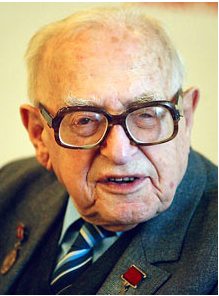 |
| Boris Efimov near the end of his life. |
Efimov was born in 1900 in the city of Kiev, where his father, Efim Fridliand, worked as a cobbler. The family relocated shortly after Boris’s birth to Bialystok, where Boris and his brother Mikhail went to school. Both would change their names from Fridliand to avoid the anti-Jewish violence that took place during World War I and after the 1917 Revolution and to signal their commitment to the new Bolshevik cause.
Mikhail, the elder by two years, took the name Kol’tsov and would become a noted journalist. He was later arrested, tortured, and shot during the Stalinist purges (1936-1938), a victim of the supposed conspiracies that threatened the Soviet state that Efimov, in turn, helped to conjure.
Efimov was briefly fired from his position as caricaturist, but otherwise spared. His cartoons during World War II made him even more famous within the USSR. After 1945, Efimov’s images about supposed Western malfeasance defined the Cold War for Soviet viewers.
The weapons Efimov aimed at Soviet enemies took many forms. He consistently mocked the enemies of the socialist state, drawing personifications of capitalists dressed in top hats and tuxedos. He repeatedly drew caricatures that juxtaposed the two worlds, communist and capitalist, with the former usually represented in larger-than-life form, easily towering above the representations of the latter. And he returned over and over to the idea of the “hidden hands of the West,” providing conspiratorial agency to explain events.
Boris Efimov popularized a worldview in which the “West” perpetually undermined the Soviet state. This worldview focused on political puppets and their masters, on meddling in foreign elections, on grubby paws grabbing for oil, and on handshake agreements that were not what they seemed.
As far as the power of his political cartoons, Efimov had this to say:
Cartoons are the first thing that a reader of a newspaper looks at. He takes it in more quickly and more completely than any long article you would read. A cartoon instantaneously gives you both the event and the commentary about that event. That is the nature of a cartoon: fast, funny and persuasive.
Conspiracies, Schemes, and Secret Collusions
Let’s take a peek at a number of these images and how they conjured up this reality.
"A Split Among the German Fascists," 1923-1924.
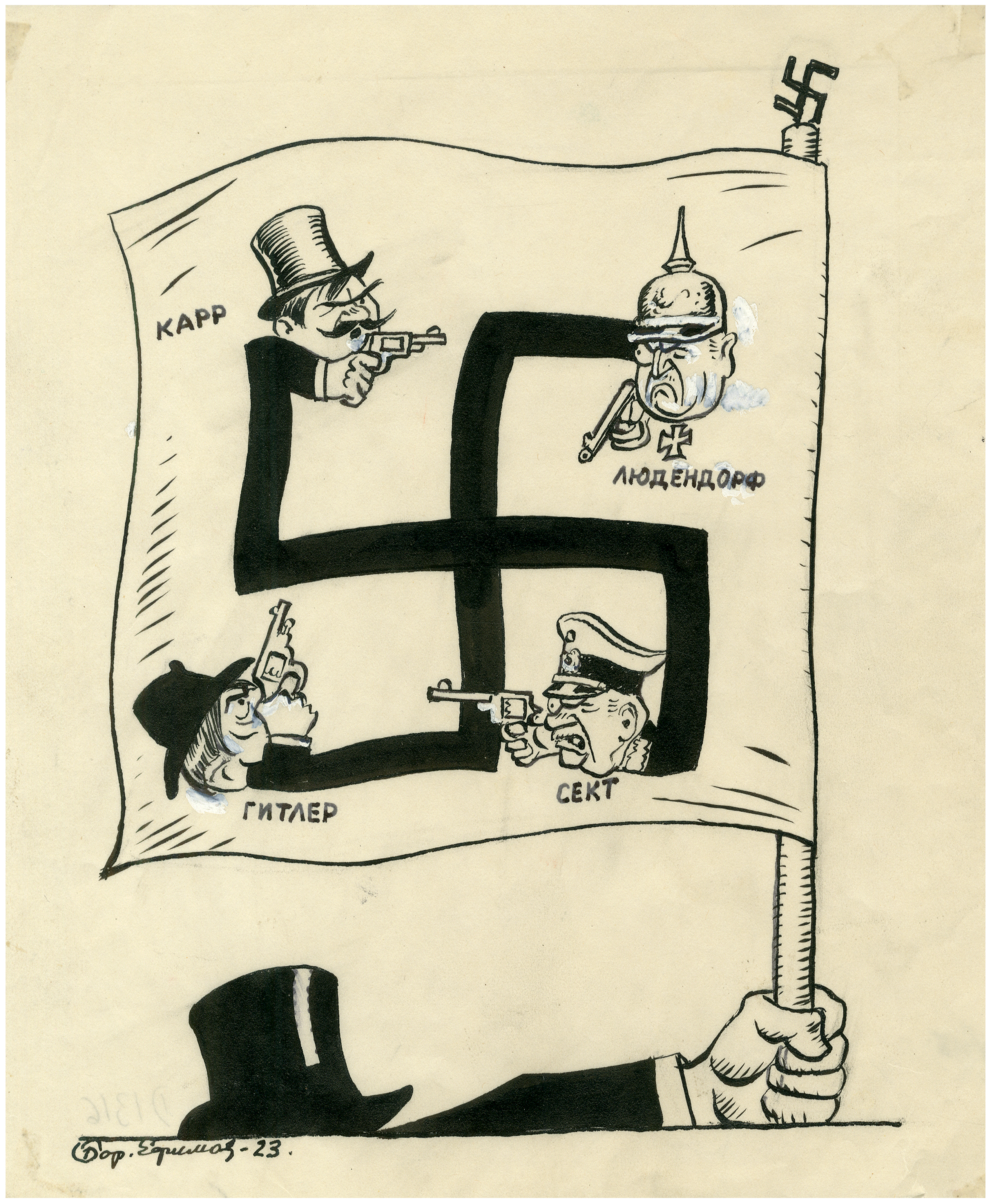
Efimov’s 1923 cartoon, which was published in 1924, is interesting for several reasons. He warned against the threat posed by the Nazis early and often: he employed this theme more frequently than any other in the 1930s and it might have saved his life during the Stalinist Purges.
Here Efimov depicts the failed November 1923 Beer Hall Putsch as one where, clockwise from the upper left corner, Gustav Ritter von Kahr, Eric Ludendorff, Hans von Seeckt, and Adolf Hitler were infighting rather than joining in a common cause. In this imagining of the events of 1923, however, Efimov introduces one more element: the unseen capitalist, symbolized by his top hat and white glove, working behind the scenes to promote fascism.

One of the primary enemies Efimov depicted in the early years of the Soviet state was Sir Austen Chamberlain, the British foreign secretary. While Chamberlain would often be lauded in the West, winning the 1925 Nobel Peace Prize along with Charles Dawes for their work on the Locarno Pact, he was seen in the USSR as a typical aristocrat whose diplomacy shielded capitalists and who all too often sided with dictators.
Efimov would make Chamberlain and his monocle into symbols of reactionary politics during the interwar years. In this cartoon, Chamberlain’s gloved hand controls the leaders of, from left to right, Finland, Latvia, Poland, Estonia, and Romania, new nations that bordered the USSR and that, by the mid-1920s, had militaristic, anti-Soviet rulers.
"Multipurpose Grabbing Gloves," 1927.

Another cartoon lambasts the “hidden” agenda of a Western diplomat, this time United States Secretary of State Frank Kellogg (who would win the Nobel Peace Prize two years later). Kellogg is dressed like a capitalist; in place of the stereotypical top hat, a dollar sign beams above his head. His gloves are marked “the fight against Soviet intrigues” and “the fight against communist propaganda,” two issues he often railed against. These slogans, Efimov suggests, are cover for his real goal: “Nicaraguan oil.” The text at the bottom of the caricature notes that Kellogg’s gloves “are suitable for all kinds of dirty work.”
These three cartoons create impressions that Efimov would hammer out again and again across the Soviet century: capitalists propped up fascism, democracies secretly pulled the strings of dictators, and lofty words about diplomacy acted as a smokescreen for the dirty work of grabbing for oil.
"Interventionists Caught Red-Handed," 1937 (left). "A Little Beast with a Big Appetite," 1937 (right).
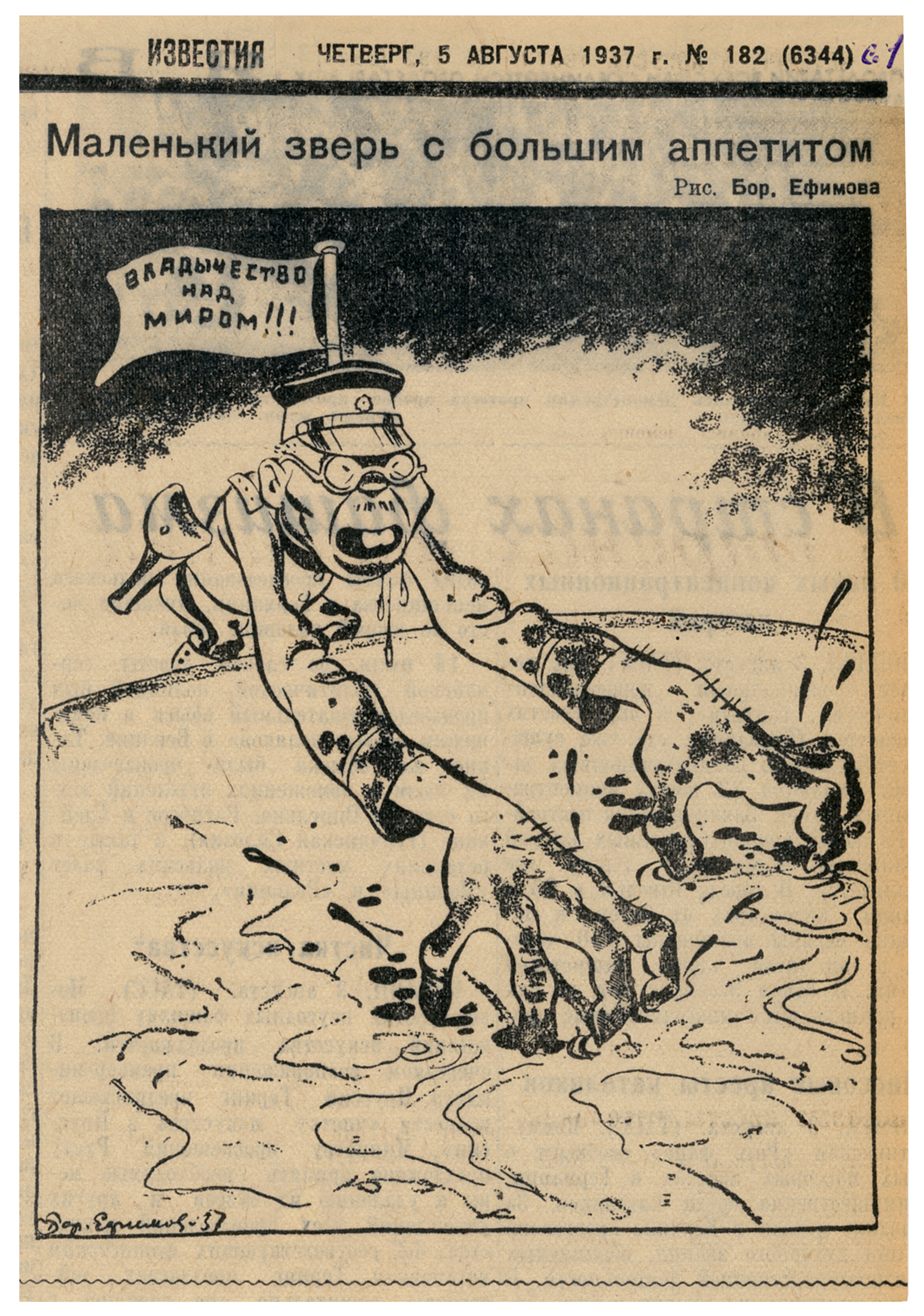
Efimov’s 1930s cartoons were dominated by his warnings against the rising threat posed by fascist nations. In these two images, both from 1937 and both published in Izvestiia, Efimov characterizes fascist Italy and fascist Japan as land-grabbing entities that, if left unchecked by Soviet power, would seize territories across the globe.
In the first, Benito Mussolini, despite having signed the Non-Interventionist Agreement in 1936, delivers a glove labeled “Italian corps of volunteer troops” to Spain. The second references the July 1937 Japanese invasion of China: Emperor Hirohito greedily lunges for the mainland; behind him flies a flag that declares “world domination!” In other cartoons from this decade, Efimov drew connections between capitalist countries who fed these fascist plans. The West’s dirty work, in other words, could be performed by others.
"The American 'Statue of Liberty'... and Hand of Freedom," 1947.

During the Second World War, when the USSR allied with the United States and Great Britain, Efimov occasionally depicted the hands of these three countries working together. At the same time, he also drew cartoons that illustrated Soviet worries that the two allies secretly colluded to slow down the opening of a second front in order to let their Soviet ally bear the brunt of the fighting.
That sort of deception, combined with the prewar worldview illustrated in the cartoons above, informed Efimov’s Cold War caricatures. Over the course of forty years, he would again and again depict the American enemy as duplicitous, money-grubbing, and deceptive. This 1947 cartoon illustrates a Soviet vision of what the postwar Marshall Plan was really about: the dollars held by Lady Liberty are a front for American capitalists and thugs to build a complicit Europe. “Freedom,” in short, was a sham.

In his early cartoons, Efimov depicted the gloved hand of capitalism in a general sense—it could belong to a British politician, an American businessman, or a “Western” capitalist. By 1950, that hand always had a dollar sign emblazoned on it. In this image, Léon Blum, Jules Moch, Georges Bidault, and René Pleven, all French political figures of the Fourth Republic, lick hands marked “Wall Street,” “US State Department,” and “American Intelligence.” The postwar European integration that they favored is here exposed as an American conspiracy.
"The Brown Web," 1951 (left). "'Their' Hand of Friendship," 1954 (right).

As the Cold War heated up, Efimov turned to familiar themes in his cartoons. The division of Germany and American support for Konrad Adenauer’s Christian Democratic Party (and later the American decision to allow the Bundeswehr to form) were cast as “Wall Street” spinning a web that allowed Nazism to resurface. Carrying a suitcase branded with “plans for aggression,” a stereotypical top-hatted capitalist was mocked for the pretense behind his seeming friendliness: in this vision, smiles and handshakes masked the militaristic pursuit of American capitalism.
"Polluters of the Atmosphere," 1956.
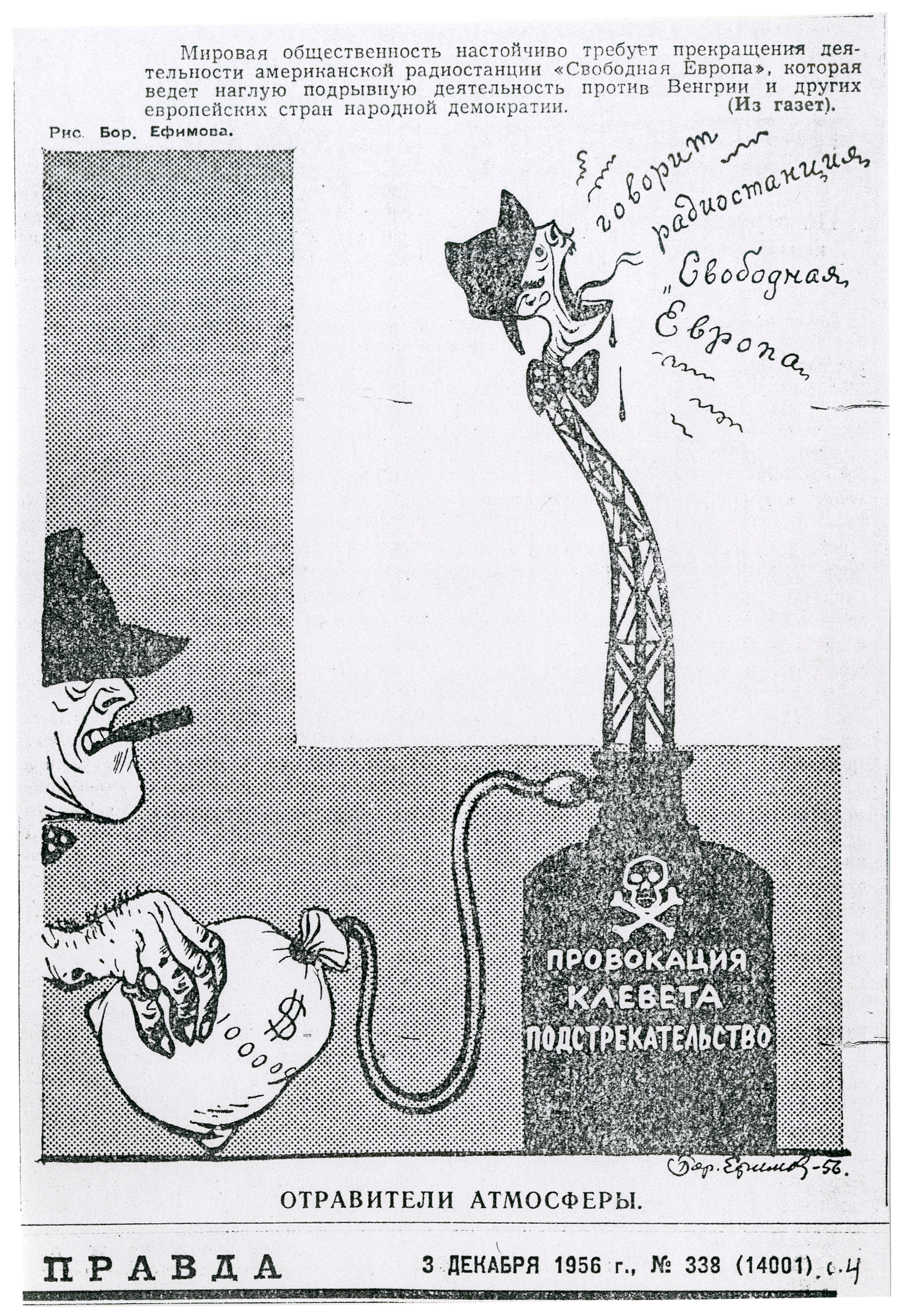
During the Hungarian Revolution of 1956, Efimov suggested that reports airing on the American-funded Radio Free Europe network were “fake news” (before the term existed, of course). At the top of his December 3 caricature, a caption borrowed from a Soviet news report reads: “The world urgently demands the closure of the American Radio Free Europe network, which is engaged in shameless, undermining propaganda against Hungary and other European countries of people’s democracies.” A shady American official pumps a bag of money into a canister that reads “provocations, lies, incitement.” The head at the top of the radio tower belches out the words: “you are listening to Radio Free Europe.”
In other cartoons, Efimov would cast the Voice of America similarly: in the Soviet imagination, American media broadcast fake news throughout the Cold War.
The network, as documents available through the National Security Archive show, played an important role in the October-November Revolution. Broadcasts suggested the West would help the Hungarian rebels and encouraged them to fight. One month before Efimov published his cartoon, however, Soviet troops invaded Hungary and crushed the rebellion.
Here Efimov visualizes a concluding narrative to this event, casting it in all-too-familiar terms: the hidden hands of American capital conspired to lie to Hungarians, creating the provocation that needed to be quelled by the USSR.
"New Shackles for the People of the Congo," 1960.
The hands of Cold War-era America reached far. In this cartoon from 1960, Efimov characterized the beginning of what would be a six-year crisis in the Congo after it gained independence from Belgium. He did so by linking three prominent participants in the power struggle to American power, again symbolized by hands and gloves bearing the dollar sign.
Moise Tshombe, who would declare his home province of Katanga a separate state in the crisis, links arms with Joseph Kasavubu, the first democratically elected President of the Congo. Kasavubu links his arm through the steel jaws of Joseph Mobutu, who would seize power in 1965, rename the country Zaire, and rule over an authoritarian system until 1997. Although the three men disagreed on many points, Efimov drew them together, linked through American manipulation.
Absent is Kasavubu’s prime minister, Patrice Lumumba, who had helped to bring about independence and, after the initial chaos of 1960, appealed to both the United Nations and the United States for assistance. When he was refused, Lumumba turned to the USSR and received aid. This turn brought Kasavubu and Mobutu, who served as chief of staff, closer together. They had Lumumba arrested and executed by a Katangan firing squad in 1961.
In 2014, when the U.S. State Department published documents on the Congo crisis, they confirmed that the CIA had played a role in Lumumba’s assassination. The Office of the Historian has stated officially that from 1960 to 1965, “the United States repeatedly attempted to create a stable, pro-Western regime through vote buying and financial support for pro-Western candidates.”
In Moscow, Soviet media consistently maintained that the hands of American power had orchestrated the events in Congo. In 1961, Soviet officials even renamed their year-old People’s Friendship University after Lumumba.
"The Predatory Hands of the 'Free World,'" 1961.
The predatory land-grabbing hands that had once belonged to fascist leaders such as Mussolini turned exclusively American after World War II.
In this 1961 cartoon, an American general eyes Cambodia; his finger puppets bray “there are communist bases in Cambodia,” providing the justification for intervention. His gloves betray a different story, for they are marked “Thailand” and “South Vietnam.” While depicting this rapacious appetite as routine, Efimov is also mocking the 1947 Truman Doctrine, which declared that the United States, as the “leader of the free world,” must provide political, military, and economic assistance to all democratic countries threatened by authoritarianism.
Cold War-era cultural exchanges and tourism were CIA fronts, at least in this Efimov imagining from 1967. A shadowy figure who would not have been out of place in Mad magazine’s “Spy vs Spy” series (created in 1961), is marked with the Russian letters for “CIA.” The smiling American tourist’s hat exposes him: it is branded with NSA, for the National Security Agency. His folders may state “cultural exchange” and “tourism,” but his legs are supported by the dollar and his movements are orchestrated by his shadowy puppet master.
"The Hands of the Pentagon over the Middle East," 1970.
Despite Efimov’s Jewish background, he drew a number of nasty, anti-Semitic, anti-Zionist cartoons after 1967 and received numerous angry letters from Soviet Jews. In this cartoon, though, he toned down these tendencies to characterize American support for Israel as aid that slotted into a tendentious tradition. An American military figure has a dove finger puppet bearing in its beak a document promising a peaceful settlement to the Middle East conflict. His other hand, however, betrays this promise, for its puppet delivers military aid to Israel.
Efimov would return to his vision of American hypocrisy in this cartoon, which lambasts the “Star Wars” (SDI) initiative under Ronald Reagan. With a rhyming text that declares, “Their love of peace is cracking at the seams when such a shield hangs over the world,” Efimov once again casts a crouching American military figure, with dollar signs on his epaulettes, grabbing a shield for “defense” in his long arm. The shield, of course, acts as cover for the offensive capabilities of the United States.
Here Efimov captures the Soviet view that the United States was “militarizing space” in the Cold War, a view that even colored Soviet reviews of George Lucas’s Star Wars trilogy.
During the 1920s, Sir Austen Chamberlain held finger puppets of Central European dictators controlled by British capital. While the figures, fingers, and hands changed, the basic sentiment expressed in these early Soviet cartoons—that the “West” conspired to manipulate events behind the scenes—did not.
In this cartoon, the 85-year old Efimov returned to one of his favorite themes. This Uncle Sam pulls the dollar-sign strings of chairs marked with “El Salvador dictatorship,” “Guatemala dictatorship,” “Paraguay dictatorship,” “Chile dictatorship,” and “Haiti dictatorship.”
In 1925, Chamberlain’s puppets included authoritarian leaders such as Carl Gustav Emil Mannerheim and Józef Piłsudski. By 1986, the “West’s” chief puppet master was Uncle Sam; his puppets included Augusto Pinochet and Alfredo Stroessner. The principals had changed; the song remained the same.
The West and Russia’s Conspiratorial Worldview
In an interview from 1999 with PBS for its “Red Files” documentary, Efimov stated the following about his cartoons and their depiction of “the West”:
Cartoonists’ images reflect reality, what is going on in the world, what is going on in our country. Cartoons are a mirror to reality. In my caricatures and political drawings, I portrayed the West. Although “the West” is a very broad term, if you take it to mean everything outside our country, it seemed to us unfortunately for many years something of an enemy, something contradicting the order and values we had in our country. It is not because people wanted it to be that way, that we should be the opposite of the West. It just happened that way. I should say that there were two types of cartoon. There was the humorous cartoon, funny, kind, entertaining, but there was also the cartoon that was bitter, mean, offensive, exposing, those which were used as satirical weapons for those countries that considered themselves in danger. Although I made many simple, humorous cartoons, happy ones that entertained people, at the same time my job as a political cartoonist was also to expose and make fun of or brand a disgrace whichever of our enemies the given occasion demanded. That was my main task.
When asked about how he turned wartime allies into Cold War enemies, Efimov answered:
When the war finished, and our allies stopped being our allies, there was created a situation where we started to depict them as a kind of enemy, as aggressors. During the war I was already caricaturing the Americans with dollar signs. It was, of course, still something both unclear and also unpleasant. But that was the politics of the Soviet Union at the time. The same was true of the politics of the West. We portrayed Churchill and Truman as aggressors and warmongers, and the West portrayed Stalin and Molotov as aggressors and warmongers as well.
Efimov’s exhaustive output from 1922 to 1991 contained repetitive themes, in turn visualizing a remarkably consistent worldview. Efimov was not the only caricaturist who constructed this Soviet vision; dozens of friends and peers produced thousands of similar images across the history of the USSR.
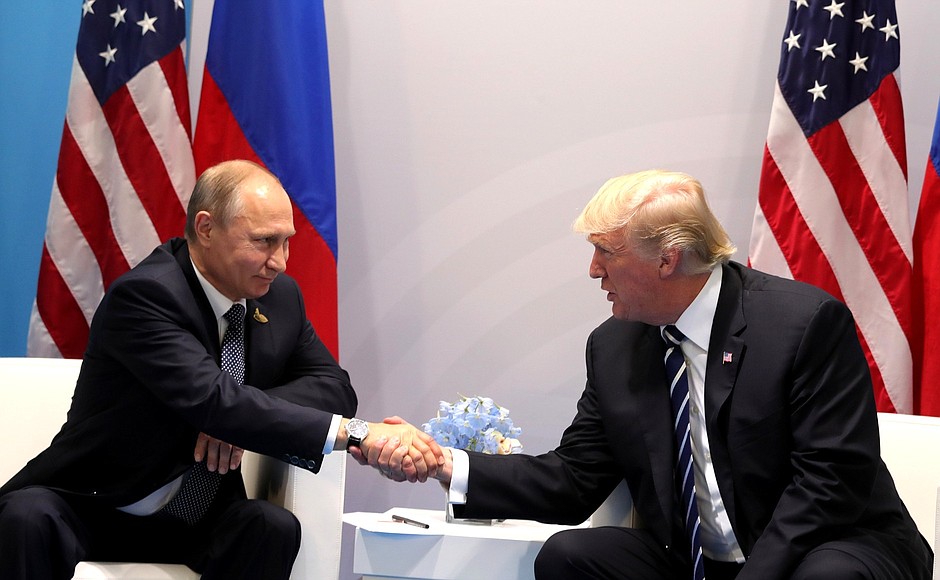 |
| Russian President Vladimir Putin and American President Donald Trump meeting in July 2017 at the G20 Summit. |
Boris Efimov was a propagandist and historian all at once. He regularly interpreted current events, giving them meaning by slotting them into a framework he had helped to construct. His cartoons played a major role in the cultural construction of the new Soviet society and he attempted to fashion a “Soviet” way of seeing the world.
This way of seeing the world has evolved since 1991, but persists nonetheless. Russian television viewers today can tune in to Dmitrii Kiselev’s popular Sunday program, “Weekly News,” to hear about how the West continues to work against Russia.
Among other recent claims, Kiselev has stated that the United States sided with ISIS in Syria in order to “destroy Syria as a secular state.” For English-language readers, Sputnik, an arm of the state media agency Rossiia Sevognia, regularly publishes articles aimed to counter what it argues is Western propaganda against Russia (Kiselev is the agency’s chief). Recent articles have contended that the CIA has fomented unrest in Ukraine since 1991, that Euromaidan was a U.S.-Polish “special operation,” and that sanctions against Russia highlight an American obsession with regime change.
Perhaps the best example of the connections between past and present worldviews can be located in another recent Sputnik article on Syria. Entitled “Bloody Track Record,” the article disputes the June White House report claiming Assad is preparing for another chemical weapons attack.
Vatalii Podvitskii, "Trophies," 2017.
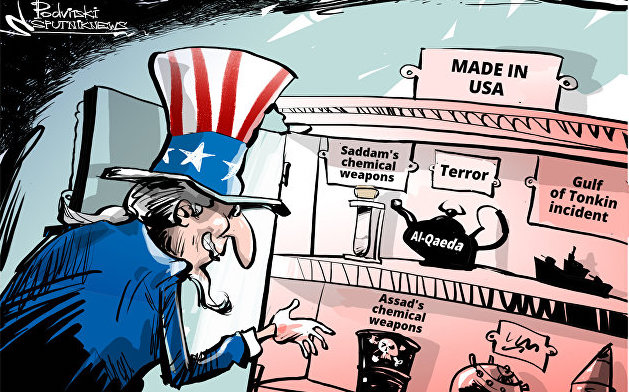
Vitalii Podvitskii’s cartoon, “Trophies,” accompanies the Sputnik report. It’s a very Efimov-like portrait of Uncle Sam’s willing hands, an image Podvitskii has rendered in other caricatures. In an email exchange, Podvitskii stated that he continues Efimov’s work of “pro-Russian patriotic cartoons,” a tradition no other contemporary Russian caricaturists took up. While his work is inspired by present-day American political cartoonists, Efimov “remains a true teacher.”
Efimov died in 2008, shortly after his 108th birthday. The worldview he helped to construct, one full of conspiracies, duplicity, fake news, hidden hands and not-so-hidden aggression, however, has lived on.
Boris Efimov’s original drawings are located at the remarkable poster archive in Prague: Ne Boltai! Collection.
Borenstein, Eliot. “Plots Against Russia” (work in progress): http://plotsagainstrussia.org/
Brandenberger, David. Propaganda State in Crisis: Soviet Ideology, Indoctrination, and Terror under Stalin, 1927-1941 (New Haven: Yale University Press, 2012).
Kenez, Peter. The Birth of the Propaganda State: Soviet Methods of Mass Mobilization, 1917-1939 (Cambridge: Cambridge University Press, 1985).
Norris, Stephen M. “The Sharp Weapon of Soviet Laughter: Boris Efimov and Visual Humor” Russian Literature 74/1-2 (2013): 31-62.
Norris, Stephen M. “Laughter’s Weapon and Pandora’s Box: Boris Efimov in the Khrushchev Era” in David Goldfrank and Pavel Lyssakov, eds., Cultural Cabaret: Russian and American Essays in Memory of Richard Stites. (Washington, DC: New Academic Press, 2012): 105-138.
Ortmann, Stefanie and John Heathershaw, “Conspiracy Theories in the Post-Soviet Space” Russian Review 71 (October 2012): 551-564.
Wolf,Erika. Koretsky: The Soviet Photo Poster, 1930-1984 (New York: The New Press, 2012).
Wolf,Erika. Aleksandr Zhitomirsky: Photomontage as a Weapon of World War II and the Cold War (New Haven: Yale University Press, 2016).
Yablokov, Ilya. “Conspiracy Theories as a Russian Public Diplomacy Tool: The Case of Russia Today (RT)” Politics 35/3-4 (2015): 301-315.
Yablokov, Ilya. “Pussy Riot as Agent Provocateur: Conspiracy Theories and the Media Construction of Nation in Putin’s Russia” Nationalities Papers 42/4 (2014): 622-636.

